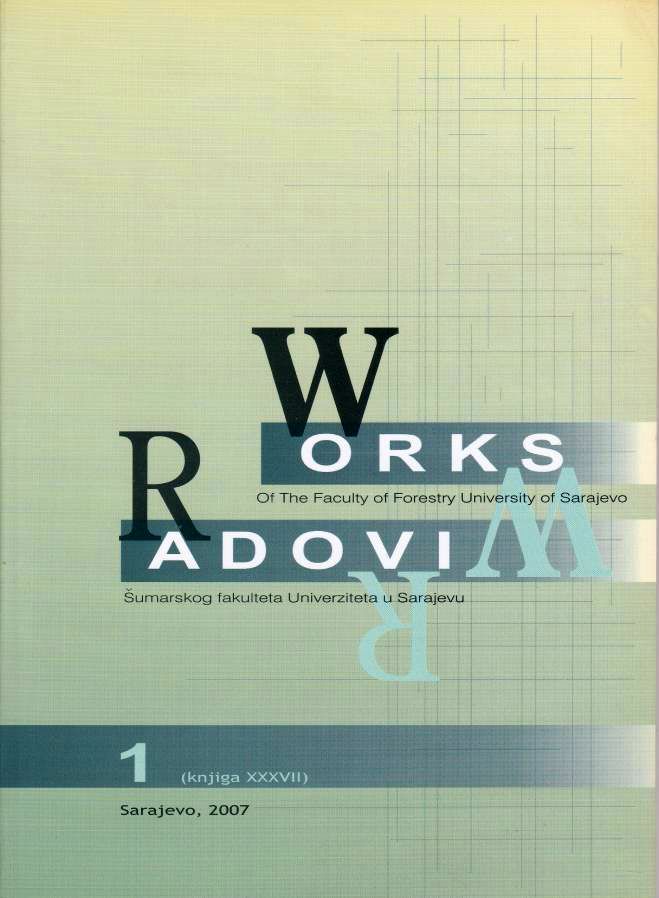Presence of the rhizomorphs of Armillaria genus in the managed forest and the virgin forest of „Ravna Vala“ at the mountain complex Bjelašnica – Igman
DOI:
https://doi.org/10.54652/rsf.2007.v37.i1.179Keywords:
rhizomorphs, Armillaria spp, forests of Common beech and Silver fir with Norway spruce, virgin forestAbstract
UDK 630*44:582.284 (234 Bjelašnica - Igman)
The reasearch work on the presence of rhizomorphs in the soil was performed in the virgin forest resort of “Ravna vala” and in the managed forests of the mountain resort Bjelašnica – Igman. The selection of the stands of economic character was made with the intention to provide a more balanced influence of ecological factors (altitude, exposition, inclination, type of soil and stem substrate) that are peculiar for virgin forest objects of this location.
With a view to determine the presence of the genus of Armillaria species we collected a total of 96 samples, 48 from the virgen forest, and 48 from the managed forest type. The presence of rhizomorphs was verified in both studied forest types. The rhizomorphs were most frequently represented in the surface layer of the soil. The greatest number of rhizomorphs was verified in the layer at 10 cm depth. In the parts of the studied areas, specific for their rocky, arenaceous and erroded soils, the rizomorfes appeared at greater depths, at times as deep as 18 cm. The presence of the dead organic substance affects the quantity of rhizomorphs in the soil. Greater quantities of these organs were determined in places at which there was a more significant presence of dead organic substance (drifts/slides, breakages or sliver after tree felling/cutting).
The resultas of the studies of Armillaria species in the forest eco-systems of the mountain resort Bjelašnica – Igman indicate variation in lengths and masses of their rhizomorphs. Despite major differences in quantities of rhizomorphs, which became apparnet at the places of sampling, the statistical analysis indicated that there is no statisticially significant difference in lengths of these organs in the managed forests and the virgen forest of the researched site. These results are perhaps conditioned by similatrities of the stand characteristics among the analyzed objects.
Downloads
References
ADASKAVEG, J.E.; MILLER, R.W.; AND GILBERTSON, R.L. (1993): Wood Decay, Lignicolous Fungi, and Decline of Peach Trees in South Carolina. Plant Disease 77: 707-711.
BLOOMBERG, W.J. AND MORRISON, D.J. (1989): Relationship of the growth reduction in Douglas-fir to infection by armillaria root disease in Southeastern British Columbia. Phytopathology 79: 482-487.
BRUHN, J.N.; WETTEROFF, JR. J.J.; KABRICK, J.M.; AND PICKENS, J.B. (2000): Distribution of Armillaria species in upland Ozark Mountain forests with respect to site, overstory species composition and oak decline. Forest pathology 30: 43-60.
BURRILL, E.A.; WORRALL, J.J.; WARGO, P.M.; AND STEHMAN, S.V. (1999): Effects of defoliation and cutting in eastern oak forests on Armillaria spp. and a competitor, Megacollybia platiphylla. Canadian Journal of Forest Research 29: 347-355.
ENTRY, J.A.; CROMACK, JR. K.; HANSEN, E.; AND WARING, R. (1991a): Response of Western Coniferous Seedlings to Infection by Armillaria ostoyae Under Limited Light and Nitrogen. Phytopathology, 81: 89-94.
ENTRY, J.A.; CROMACK, JR. K.; KEISEY, R.G.; AND MARTIN, N.E. (1991b): Response of Douglas-Fir to Infection by Armillaria ostoyae after Thinning or Thinning Plus Fertilization. Phytopathology, 81: 682-689.
GUILLAUMIN, J.J.; MOHAMMED, C.; ANSELMI, N.; COURTECUISSE, R.; GREGORY, S.C.; HOLDENRIEDER, O.; INTINI, M.; LUNG, B.; MARXMÜLLER, H.; MORISSON, D.; RISHBETH, J.; TERMORSHUITZEN, A.J.; TIRRÓ, A.; VAN DAM, B. (1993): Geographical distribution and ecology of the Armillaria species in western Europe. European Journal of Forest Pathology 23: 321-341.
LEGRAND, P.; GHAHARI, S.; AND GUILLAUMIN, J-J. (1996): Occurrence of genets of Armillaria spp. in four mountain forests in Central France: the colonization strategy of Armillaria ostoyae. New Phytologist 133: 321-323.
MATIĆ, V.; DRINIĆ, P.; STEFANOVIĆ, V. I ĆIRIĆ, M. (1971): Stanje šuma u SR Bosni i Hercegovini prema inventuri šuma na velikim površinama u 1964-68. godini. Posebno izdanje Šumarskog fakulteta i Instituta za šumarstvo. Sarajevo.
PRONOS, J. AND PATTON, R.F. (1978): Penetration and colonization of oak roots by Armillaria mellea in Wisconsin. European Journal of Forest Pathology 8: 259-267.
PROSPERO, S.; RIGLING, D.; AND HOLDENRIEDER, O. (2003): Population structure of Armillaria species in managed Norway spruce stands in the Alps. New Phytologist 158: 365-373.
ROBINSON, R.M. (2003): Short-term impact of thinning and fertilizer application on Armillaria root disease in regrowth karri (Eucalyptus diversicolor F. Muell.) in Western Australia. Forest Ecology and Management 176: 417-426.
SINGH, P. (1981): Armillaria mellea: Growth and distribution of rhizomorphs in the forest soils in Newfoundland. European Journal of Forest Pathology 11: 208-220.
STANOSZ, G.R. AND PATTON, R.F. (1990): Stump colonization by Armillaria in Wisconsin aspen stands. European Journal of Forest Pathology 20: 339-346.
STANOSZ, G.R. AND PATTON, R.F. (1991): Quantification of Armillaria rhizomorphs in Wisconsin aspen sucker stands. European Journal of Forest Pathology 21: 5-16.
TOPALOVIĆ, M. I TRAVAR, J. (1978): Tumač pedološke i tipološke karte za gospodarske jedinice “Igman”, “Zujevina” i “Mehina luka”. Zavod za šumarstvo i lovstvo. Beograd.
TREŠTIĆ, T., USČUPLIĆ, M.; MEMIŠEVIĆ, M. I MUJEZINOVIĆ, O. (2003): Armillaria gljive u centralnoj Bosni. Radovi Šumarskog fakulteta Univerziteta u Sarajevu, No 1/2003, pp: 41-46.
TWERY, M.J.; MASON, G.N.; WARGO, P.M.; AND GOTTSCHALK, K.W. (1990): Abundance and distribution of rhizomorphs of Armillaria spp. in defoliated mixed oak stands in western Maryland. Canadian Journal of Forest Research 20: 674-678.






















